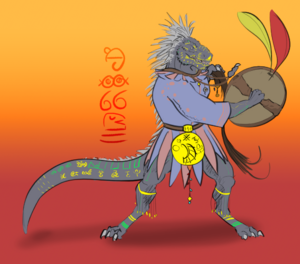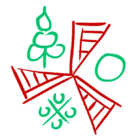Archive:Bird priest

A bird priest (mëhvizux, möixidzux, or mihína[1]; literally meaning 'inducted/initiated one' in Karakat) is a male shaman in the Karakat religion. Bird priests are the most common type of Karakat priest. Shamans similar to the bird priest have existed since at least 500AD, when the Karakat people are first mentioned in writing by Pelsic scholars. They were described as diviners who advised the Karakat kings and chiefs in matters of import, made predictions about nature and fate, and performed magic to influence them, though they were common among the population as well.
Bird priests are typically divided in two classes, the lower being uninitiated "day men", or grëcbachë, grötsbatšahö, grosbaistih with for the most part regular lives and free of most of the restrictions that come with being an initiated priest, who though still preside over healing ceremonies and holidays, tend to shrines, may impart blessings on objects and food, and carry out other minor functions.
The "bird-inducted", or mëhvijamizuxhë, möixižamidzuxahö, mihídiaiménah, are inducted shamans who have gone through an acceptance trial and are members of the brotherhood of Karakat shamans. Apprentice bird priests become inducted into the brotherhood after passing a period of trials at the hand of several elder priests, involving tests of one's strength of mind, "mystical abilities", knowledge of religious stories and folklore, as well as having them consume hallucinogens, and subjecting their body to intense duress and suffering. Inducted bird priests are considered to be able to communicate with the gods and sometimes endowed with supernatural abilities. They are taught in the oral traditions of the Karakat religion and history, and may stand at the head of religious ceremonies, although these may sometimes be overseen by grosbaists as well. Bird priests are occupied rather with mystical activities, offering their services to those who look for dream and vision interpretation, divination, blessing of fates, cursing, acting as oracles, and other things. Some bird priests are wanderers, living off donations on the road and payment for their services; with such donations being customarily expected on certain days. Karakat shamans readily use and experiment with many hallucinogenic drugs, such as psilocybin and DMT-containing plants and mushrooms, in order to gain the ability to commune with the gods.
While there are regional differences, bird priests are immediately recognisable from the general populace by their distinctive necklace called a "sun ring", or , gujëdaj, gžötaš, or kujdas, typically simply a string used to carry charms and herbs whose content increases with experience, with some older priests even having parts of their body removed and preserved to be used as a charm or wand, usually the tip of the tail, one of the little fingers or toes, or only a claw. Bird priests also carry a wide, shallow drum on the back, and their bodies are painted with religious symbols or motifs, something that used to be common for all Karakats. In the northern Karakat Confederation, where Eelgledism never had any influence, bird priests commonly wear a top called a vujburz or wöžuburdz which is a loose-fitting semi-long garment with pieces of fabric attached to it, with optional belts, bracelets and anklets of gold and beads, as well as one or more metal rings around the neck along with their charm necklace. The attire of bird priests in the south shares some similarities with that of Pelsic and Haralic Eelgledist priests which could be explained by exposure of the two religions to each other, and consists of a body-length, thick tunic-like garment that protects the wearer from cold; sandals, and a charm necklace.
Females are not allowed to become bird priests, though there is a group referred to by blessed women of which at least one used to live in or around most settlements, traditional medicine ladies that do not follow the Karakat religion, and are not endorsed by the shamanic order. Rare male members of this practice existed until into the 1600s as well. The origins of the blessed women are speculated to stem from a remnant of a pre-Karakat Fals substrate culture, perhaps Kiorian or another Mherdic Fals population. This tradition is now threatened by the increasing age of its members and lack of transmission to younger generations.
Controversy
Karakat shamans have a highly controversial reputation abroad, and only varying degrees of support even in other parts of the Fals Empire and the rest of the Fals world. Due to their influence within Karakat politics, the shamanic order has been able to keep the Confederation a de facto theocracy in spite of being part of a secular state, owing to the fact that the confederation enjoys an almost complete autonomy within the Fals Empire as one of its membership conditions, being free from having to adopt most imperial legislation depending on how the confederation votes.
One of the most noticeable and perhaps superficial reasons for its controversial status has always been that the consumption of drugs is eminently legal, which is not necessarily shunned by Eelgledism (but is nevertheless discouraged and stigmatised), but is by many non-Fals religions. Likewise, the cultivation of psychoactive plants and mushrooms is universally legal within the Confederation, even if their consumption is considered to be a socially enforced privilege preserved for the spiritual class. Secondly, the Karakat religion considers physically and mentally disabled people, homosexuals, and transgender people to be afflicted by curse or possession, and bird priests are regularly employed by individuals or communities to attempt and reverse the "curse", often through methods that include affliction of mental or physical suffering. For example, it is traditionally accepted that even those who are born blind are considered to have seen Ammot first hand, and therefore must have their spirit cleansed as soon as possible through ways such as blood cleansing with leeches, exposure to fire, or by scarring the person with healing or protective patterns.
The practice of sacrificing humans is perhaps the primary reason for their negative appeal, even if the practice is far from common, although it was general practice everywhere in Karakat-inhabited regions until well into the 1900s, with the Eelgledist Saarians perhaps being an exception to this. Most notably, for shamans in and around Batšörždzö, but also in some other places, it is still normal to incorporate human sacrifices in their rituals, and there is an active underground human trade network to facilitate it. These shamans carry human body parts on their charm necklaces, some of whom have necklaces entirely made up of human reproductive organs. Such priests often come up in criminal cases as witnesses, having been consulted by people who have committed acts of violence. Even though now relatively uncommon, even priests who do not practice human sacrifice recognise that human body parts are more desirable for divination than parts of animals.
- ↑ translations into Karakat languages are ordered as such: Akiaian, Arvian, and lastly Saarian.
